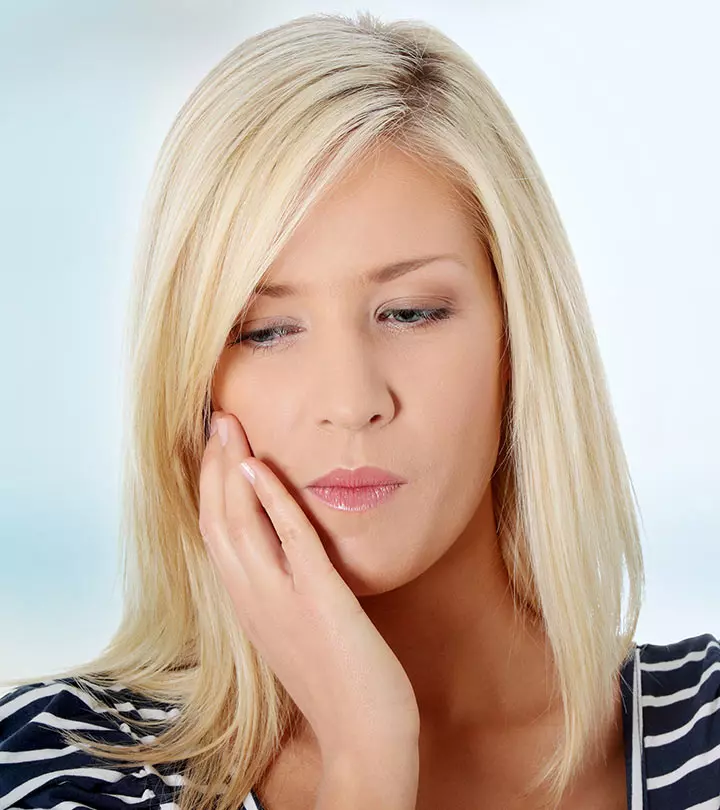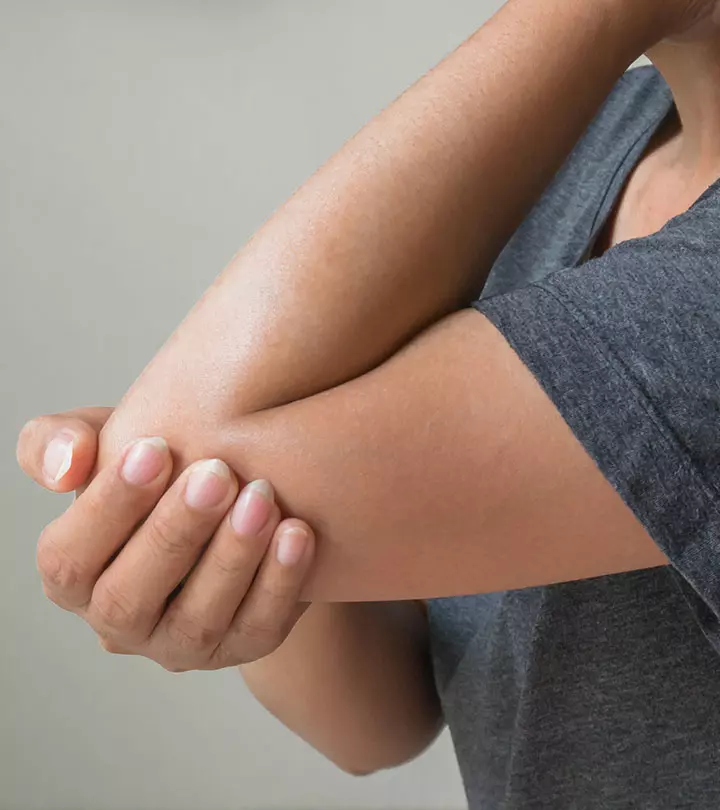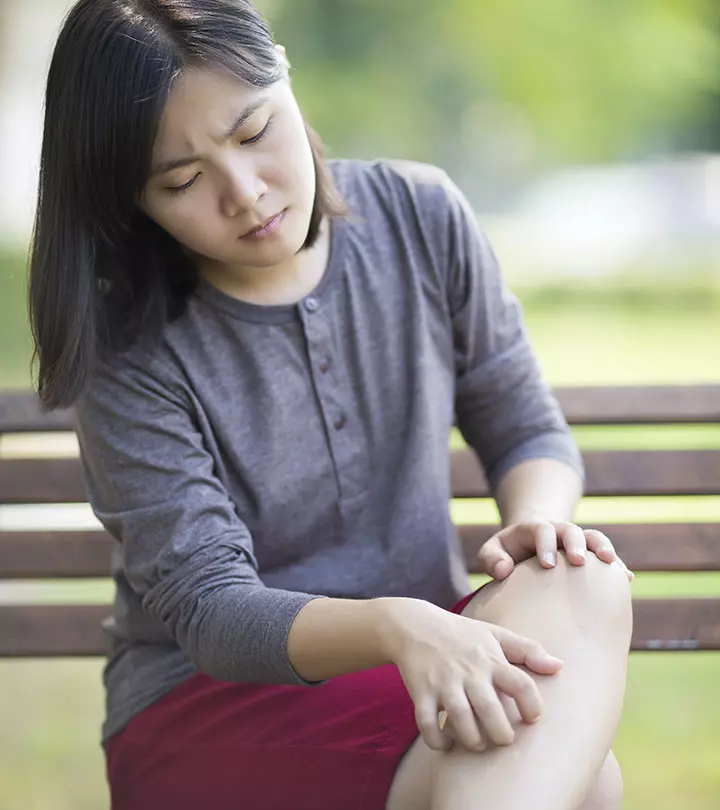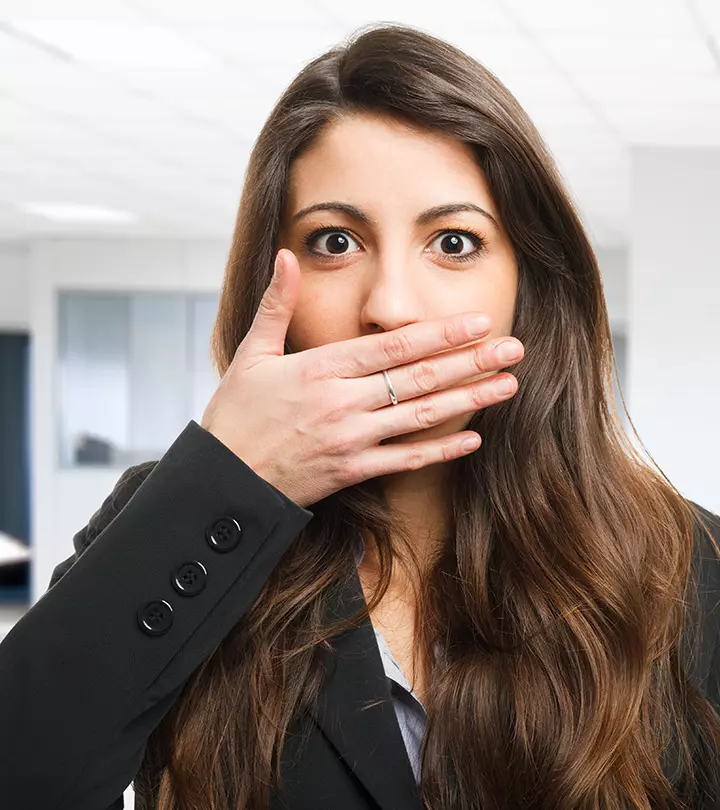10 Effective Home Remedies To Get Rid Of Hip Bursitis
Get to the bottom of what's causing your lower hip and back pain and what to look out for.

Image: ShutterStock
If you are unsure about what’s causing your lower hip and back pain, it could be hip bursitis. If you want to learn how to get rid of hip bursitis, you have come to the right place.
Hip bursitis induces pain and swelling in the hip area, making everyday life difficult. Bursitis refers to the inflammation of a bursa. A bursa is a fluid-filled sac that protects muscles, ligaments, tendons, and skin from rubbing against bone and causing friction. There are around 160 bursae in the human body.
Bursae near the knees, heels, shoulders, elbows, and hips become inflamed more frequently than the others. This is how hip bursitis develops. Keep reading to learn more about hip bursitis and how to treat it. Scroll down!
In This Article
What Causes Bursitis In The Hip?
Hip bursitis or trochanteric bursitis is the inflammation of bursa in the hip region.
This occurs due to the vigorous activities that inflict pressure on the bones or the bursa. The common cause for hip bursitis are –
- Incorrect posture at work or home
- Exertion of the hip muscles and joints due to over-activity
- Bone spurs
- Injury to the hip
- Spinal issues
If you have one leg that is longer than the other, it increases the risk of developing trochanteric bursitis. Medical conditions such as diabetes, rheumatoid arthritis, gout, and thyroid diseases can also cause hip bursitis (1).
Key Takeaways
- A hip injury, incorrect postures, or spine-related problems may cause hip bursitis.
- Difficulty walking, and stiffness in the hip joints are some of the symptoms of hip bursitis.
- You can use both an ice pack and a heat pack on the affected area to reduce pain and swelling.
- Other home remedies such as massage therapy, apple cider vinegar, and mullein tea may help you get respite.
What Are Bursitis Symptoms?
Symptoms of hip bursitis include –
- Hip pain which can be sharp initially and then become a constant pain
- Pain in the outer thighs
- Swelling at the affected site
- Stiffness in the hip joint
- Clicking sensation at the hip
- Difficulty in walking (1)
Each person may experience these symptoms differently. It usually depends on several factors such as your activity level, age, and general health. For instance, when it comes to pain in the outer thighs, some may only experience it during specific activities, while others may feel it even at rest. Your doctor will ask you about these symptoms, along with your medical history to diagnose bursitis followed by a physical examination. The doctor may also suggest imaging tests like X-rays and MRIs.
Bursitis is not serious in nature. It can be easily cured with proper care of the injured or inflamed area. Home remedies are enough to cure the ailment, but if this issue is recurring frequently, you should surely consult your doctor. Let’s check out the best home remedies to cure the ailment.
How To Get Rid Of Hip Bursitis
- Essential Oils
- Heat Or Ice
- Massage Therapy
- Apple Cider Vinegar
- Milk Of Magnesia
- Turmeric
- Blackstrap Molasses
- Ginger
- Mullein Tea
- Alfalfa
Top 10 Home Remedies For Hip Bursitis
1. Essential Oils For Hip Bursitis

You Will Need
- 1/4 cup olive oil
- 4-5 drops of German chamomile oil or basil oil or rosemary oil or sweet birch oil or wintergreen oil or myrrh oil or helichrysum oili Oil made from the flowering plants in the sunflower family, which eases inflammation and also helps lower pain. or copaiba oil
What You Have To Do
- Make an oil blend by mixing the essential oil of your choice with the carrier oil.
- Apply this on the affected area and massage for a minute or two.
- Leave the oil blend on overnight.
How Often You Should Do This
Repeat this every night until the hip bursitis heals.
Why This Works
Most of these essential oils possess anti-inflammatory properties that will reduce the swelling.
They also provide heat to the skin as they are warm in nature. This can help to ease the pain and give relief (2), (3), (4),
Caution
Sweet birch oil and wintergreen oil are safe for short-term use only.
2. Heat Or Ice For Hip Bursitis

You Will Need
- An ice pack
- A heat pack
What You Have To Do
- Apply the ice pack first on the swollen parts for about 10 minutes.
- Now, place the heat pack on the same spot for 10 minutes.
- Repeat the ice pack for another five minutes.
How Often You Should Do This
Use this remedy as and when required.
Why This Works
This is a standard treatment when it comes to treating muscular pains. The initial application of the ice pack helps to reduce the pain and swelling, and numb the area. Then, the application of heat will enhance circulation to the affected site and help to heal the inflammation further. A final application of the ice pack ensures that the muscles and joints do not get inflamed again (5).
3. Massage Therapy For Hip Bursitis

You Will Need
1-2 teaspoons castor oil
What You Have To Do
- Lightly warm up the oil.
- Massage the affected area with this for a few minutes.
- Leave the oil overnight.
How Often You Should Do This
Repeat this every night, before going to bed, until you get relief from the pain and swelling.
Why This Works
As the warmth of the oil soothes the pain, the oil itself helps to reduce the inflammation with it anti-inflammatory compounds (6).
 Quick Tip
Quick Tip4. Apple Cider Vinegar

You Will Need
- 1/2 cup apple cider vinegar
- 2 cups warm water
- A soft towel
What You Have To Do
- Dilute the ACV with water and dip the towel in this.
- Wring out the excess water and wrap this towel around the affected area.
- Leave it on for an hour or so.
How Often You Should Do This
Repeat this once every day.
Why This Works
This solution, rich in vitamins and minerals, is effective in reducing the swelling. It also can enhance circulation to the region and speed up the healing process ( 7).
5. Magnesium Supplements

You Will Need
- Magnesium supplements (as directed by your doctor)
What You Have To Do
Have the magnesium supplements in the dosage recommended by your doctor.
How Often You Should Do This
As per your doctor’s advice.
Why This Works
When the magnesium levels in the body fall, metabolic and inflammatory disorders start to crop up as this mineral plays a vital role in many of these processes (8). Magnesium exerts an anti-inflammatory effect on the affected region.
 Quick Tip
Quick TipCaution
Do not use this remedy for more than one week.
6. Turmeric For Bursitis

You Will Need
- 1 teaspoon turmeric
- A glass of warm milk or warm water
What You Have To Do
- Add the turmeric to the milk and mix well.
- Drink this while the milk is still warm.
How Often You Should Do This
Have this turmeric infused milk 1-2 times every day.
Why This Works
Turmeric is known for its anti-inflammatory and antioxidant properties, which could potentially help reduce hip swelling and alleviate pain associated with hip bursitis. While these benefits have been observed in general, further research is needed to confirm its specific effects on hip bursitis (9).
7. Blackstrap Molasses

You Will Need
- 1 tablespoon blackstrap molasses
- A glass of water
What You Have To Do
Mix the molasses in water and drink this.
How Often You Should Do This
Drink a glass of this every day.
Why This Works
Blackstrap molasses are an excellent source of magnesium and potassium. They help relieve joint pain symptoms seen in rheumatoid arthritis and bursitis (10) (11).
8. Ginger

You Will Need
Few drops of ginger oil
What You Have To Do
Apply this on the affected area and massage for a minute or so, until it gets absorbed into the skin.
How Often You Should Do This
Apply this once or twice every day.
Why This Works
Ginger is commonly used to reduce both pain and inflammation at different sites of the body. Topical application of ginger oil will have a direct impact on the hip swelling. Ginger should also be included in the daily diet to keep inflammations and even infections at bay (12).
9. Mullein Tea

You Will Need
- 2 teaspoons mullein herb
- 2 cups of hot water
- A soft cloth
What You Have To Do
- Brew some fresh mullein tea by soaking the herbs in hot water for a few minutes.
- Now, dip the soft cloth in this and place this over the hip after removing any excess water from the cloth.
- Leave it on for 20-30 minutes.
How Often You Should Do This
Repeat this as and when required.
Why This Works
The herb mullein helps to reduce the swelling and pain as it is anti-inflammatory in nature (13). The warmth of the tea will also relieve the stiffness in the hip joint that you may be experiencing.
10. Alfalfa For Bursitis

You Will Need
- 1 teaspoon dried alfalfa leaves
- A cup of hot water
What You Have To Do
- Steep the alfalfa for 10-15 minutes and then strain the tea.
- Drink this.
How Often You Should Do This
Drink a cup of this herbal tea every day.
Why This Works
Drinking alfalfa tea will bring down the levels of inflammatory compounds in the body and thus give you relief from hip bursitis (14).
While these home remedies may help manage hip bursitis, seeking medical attention is important. Your doctor may recommend some treatments to help alleviate pain and heal the issue properly. Check out the section below to know what some of these treatments may be.
Treatment For Hip Bursitis
Hip bursitis often responds well to multiple treatment approaches. Initially, your healthcare provider may explore systematic measures, such as resting the affected hip, avoiding activities that exacerbate pain, and applying ice to provide relief. They may recommend physical therapy exercises to improve hip strength and flexibility. Strengthening your body with groin exercises can complement recovery from hip bursitis and other lower body conditions.
In some cases, nonsteroidal anti-inflammatory drugs (NSAIDs) may be prescribed to manage inflammation and pain. For more severe or persistent cases, corticosteroid injections, administered directly into the bursa under ultrasound guidance, may provide substantial relief (16). It is advised to consult a healthcare professional for a personalized treatment plan tailored to your specific condition.
Martha Peterson, a somatic educator and movement expert blogger, shares her take on the importance of trauma relief after undergoing a labral tear. In one of her blog posts, she writes, “Whether you get surgery for your tear or not, it is critically important to regain full muscle function of the muscles of the somatic center if you’re ever going to move efficiently again (i)”.
Note: Hip bursitis is known to often occur alongside or in association with tendonitis. So, also check out our article on natural treatments for tendonitis to curate a combination of remedies tailored to your condition if you have both.
Preventive Measures For Hip Bursitis
Here is how you can reduce the risk of hip bursitis:
- Take measures to maintain a healthy weight, as extra weight may add pressure on your hips and increase the risk of inflammation.
- Avoid overdoing activities like running and sitting for long periods, as these may strain the hip area. Take frequent breaks whenever required.
- Perform gentle stretches and exercises like bridge and clamshells to improve flexibility and strengthen the hip joint.
- Maintain a good posture to reduce strain on the hip joint.
- If you are starting a new exercise routine or a hobby that may strain the hips, gradually increase the intensity and duration. This will allow your body to adapt without straining the hips.
Infographic: 4 Simple Home Remedies For Hip Bursitis
There are several ways to get relief from hip bursitis, including medical treatment and home remedies. However, many of them warrant a lot of time, effort, and/or money. Listed in this infographic are some simple remedies for hip bursitis that you can make with ingredients available in your kitchen. Take a look.
Some thing wrong with infographic shortcode. please verify shortcode syntax
Summing It Up
The bursa, or a fluid-filled sack present in various body parts, may inflate and lead to a painful condition called bursitis. Bursitis in the hips, more specifically, happens when the bursa in the hip region is inflamed due to various reasons like injury, bad posture, bone spurs, vigorous activities, spinal issues, or certain medical conditions. Swelling, hip pain, difficulty walking, clicking in the hips, tenderness, thigh ache, discomfort, and stiffness are common symptoms of this condition. Sometimes it may also hamper your mobility. You may be able to get rid of hip bursitis using some simple home remedies like heat or ice therapy, essential oils, turmeric, apple cider vinegar, mullein tea, and alfalfa. In addition, maintaining a healthy weight, practicing good posture, and taking breaks while doing repetitive tasks may help in the prevention of hip bursitis. Lastly, pain from hip bursitis can sometimes move down toward the knees; you can check out our article on home remedies for knee pain for natural relief of joint discomfort.
We have also answered some commonly asked questions for you below.
Frequently Asked Questions
What is the role of diet in managing hip bursitis?
Diet can play a supportive role in managing hip bursitis, especially anti-inflammatory foods like fatty fish, nuts, and leafy greens. These are also rich in antioxidants that help neutralize free radicals linked to cellular damage. Incorporating these foods may help reduce swelling around the bursa easing pain and aiding recovery (15).
How long does hip bursitis take to heal?
It can take 2-8 weeks for hip bursitis to heal if other interventions like physical therapy or medication like corticosteroids are not used to get relief from the symptoms.
Is walking good for hip bursitis?
Walking becomes very uncomfortable and even painful at times when you have hip bursitis. It is best to take rest and let your body heal instead of straining it with any physical activity. Consult your healthcare provider before starting any stretching or rehabilitation exercises.
What are the best foods to eat for bursitis?
• Fruits like citrus fruits, kiwi, pineapple, papaya, bananas, etc
• Veggies such as dark green leafy vegetables, kale, bell peppers, beans, etc
• Eggs, fish, and grass-fed meats
• Walnuts and flaxseeds
• Barley, oatmeal, and other low glycemic indexi A dietary carbohydrate rating system that shows how quickly each food elevates your blood sugar levels when eaten alone. grains
Some foods that should be avoided if you are suffering from hip bursitis are –
• Processed foods
• Food with high sugar content
• Refined starch food items
• Legumes
What are the risk factors for hip bursitis?
Do not push your body—hip bursitis is a sign that you need to slow down! Factors that are associated with increased risk of hip bursitis are –
• Hip injury
• Rheumatoid arthritis
• Repetitive stress to the hip joint causing injury
• Calcium deposits on the hip bones
• Previously undergone surgery at the hip site
What exercises should you avoid if you have hip bursitis?
It is necessary that the activities that cause hip bursitis should be avoided to give relief to the inflamed bursa. Simple things like sitting in an uncomfortable chair can also lead to pain in the hips. So, try and avoid all such activities that worsen your pain. Do not exert the bones and muscles with fast-paced aerobic exercises or weight training exercises that will put pressure on the hip joint.
When to see a doctor for hip bursitis?
It is advisable to see your doctor if you experience any of the conditions listed out below with the usual symptoms of hip bursitis –
• Sharp or shooting pain
• Excessive swelling and rashes
• Persistent pain for 1-2 weeks
• Unbearable pain in the hip
• Fever
What vitamin is good for bursitis?
Vitamin C has antioxidant and anti-inflammatory properties that may help reduce bursitis-related inflammation (16).
What happens if hip bursitis goes untreated?
Untreated bursitis may lead to health complications like septic bursitis ( inflammation of the bursa due to infection), osteomyelitis (infection in the bones), and chronic sinus (17).
How should I sleep with hip bursitis?
Individuals with bursitis are recommended to sleep on their backs on a soft mattress. If one wishes to sleep on their side, they can place a pillow between their knees to keep the hips aligned.
Find relief from hip bursitis pain with easy self-treatment techniques shared in this informative video. Discover how to alleviate discomfort and improve your mobility from the comfort of your home.
Personal Experience: Source
StyleCraze's articles are interwoven with authentic personal narratives that provide depth and resonance to our content. Below are the sources of the personal accounts referenced in this article.
i. My Daily Somatics Hip Pain Relief Routinehttps://essentialsomatics.wordpress.com/2015/04/10/my-daily-somatics-hip-pain-relief-routine/
References
Articles on StyleCraze are backed by verified information from peer-reviewed and academic research papers, reputed organizations, research institutions, and medical associations to ensure accuracy and relevance. Read our editorial policy to learn more.
- Bursitis
https://www.ncbi.nlm.nih.gov/books/NBK513340/ - Chamomile: A herbal medicine of the past with bright future
https://www.ncbi.nlm.nih.gov/pmc/articles/PMC2995283/ - Ocimum sanctum Linn. A reservoir plant for therapeutic applications: An overview
https://www.ncbi.nlm.nih.gov/pmc/articles/PMC3249909/ - The Effectiveness of Aromatherapy in Reducing Pain: A Systematic Review and Meta-Analysis
https://www.ncbi.nlm.nih.gov/pmc/articles/PMC5192342/ - Ice therapy: how good is the evidence?
https://pubmed.ncbi.nlm.nih.gov/11510876/ - Antioxidant, Antimicrobial, and Free Radical Scavenging Potential of Aerial Parts of Periploca aphylla and Ricinus communis
https://www.ncbi.nlm.nih.gov/pmc/articles/PMC3418662/ - Comprehensive investigations for a potential natural prophylaxis-A cellular and murine model for apple cider vinegar against hydrogen peroxide and scopolamine induced oxidative stress
https://pubmed.ncbi.nlm.nih.gov/34184291/ - Magnesium supplementation, metabolic and inflammatory markers, and global genomic and proteomic profiling: a randomized, double-blind, controlled, crossover trial in overweight individuals
https://pubmed.ncbi.nlm.nih.gov/21159786/ - Turmeric, the Golden Spice
https://www.ncbi.nlm.nih.gov/books/NBK92752/ - A pilot study of potassium supplementation in the treatment of hypokalemic patients with rheumatoid arthritis: a randomized, double-blinded, placebo-controlled trial
https://pubmed.ncbi.nlm.nih.gov/18468955/ - Magnesium increases numbers of Foxp3+ Treg cells and reduces arthritis severity and joint damage in an IL-10-dependent manner mediated by the intestinal microbiome
https://pubmed.ncbi.nlm.nih.gov/37201335/ - The Amazing and Mighty Ginger
https://www.ncbi.nlm.nih.gov/books/NBK92775/ - Biological activity of common mullein, a medicinal plant
https://pubmed.ncbi.nlm.nih.gov/12241986/ - Ethyl acetate extracts of alfalfa (Medicago sativa L.) sprouts inhibit lipopolysaccharide-induced inflammation in vitro and in vivo
https://pubmed.ncbi.nlm.nih.gov/19594948/ - Effectiveness of an anti-inflammatory diet versus low-fat diet for knee osteoarthritis: the FEAST randomised controlled trial protocol
https://pmc.ncbi.nlm.nih.gov/articles/PMC10989185/ - Effect of vitamin C on inflammation and metabolic markers in hypertensive and/or diabetic obese adults: a randomized controlled trial
https://www.ncbi.nlm.nih.gov/pmc/articles/PMC4492638/ - Septic Bursitis
https://www.ncbi.nlm.nih.gov/books/NBK470331/
Read full bio of Dr. Zeel Gandhi
Read full bio of Kushneet Kukreja
Read full bio of Arshiya Syeda
Read full bio of Dipti Sharma



























Community Experiences
Join the conversation and become a part of our empowering community! Share your stories, experiences, and insights to connect with other beauty, lifestyle, and health enthusiasts.